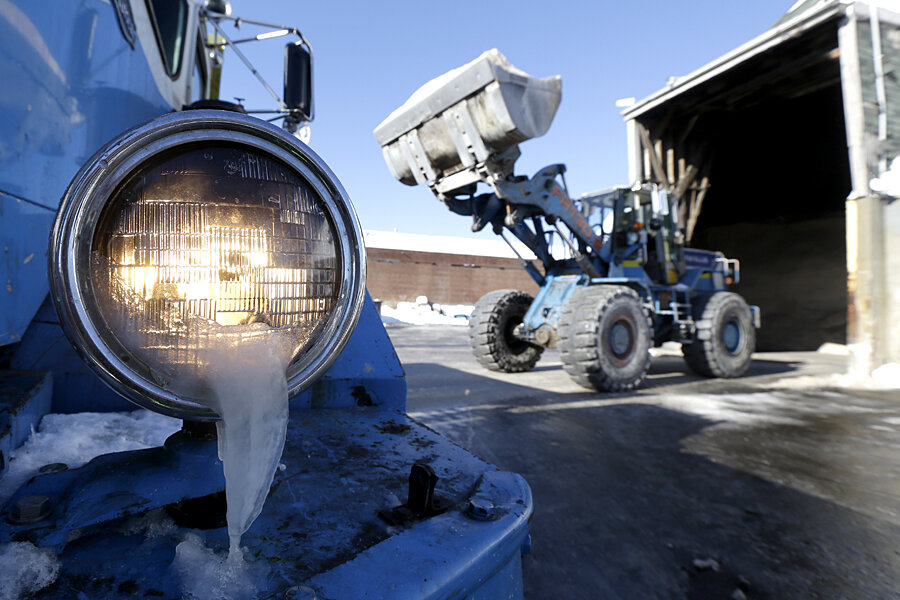Big winter: Snow-clearing crews live hand to mouth, as road salt runs low
Loading...
| New York
Got salt?
After being peppered with yet another layer of the other white stuff Tuesday morning, road crews in New York and New Jersey are running low of the warehoused rock salt they’ve been scooping into trucks and then methodically spraying over perpetually icy streets.
From the windswept Northeast to the shivering Midwest, states' transportation departments and local municipalities have been reporting shortages of de-icing salt reserves – even as America’s salt producers and distributors are having trouble keeping pace.
In Jersey City, N.J., just across the Hudson from Manhattan, city officials are waiting for more shipments of salt, even as they begin to use construction scoops and semis to truck out all the snow piled up from a week of relentless blizzards.
“We go through about 800 tons of salt per storm," said Jersey City Mayor Stephen Fulop on Monday. “We’re getting 500 today, so we’re not really up to where we need to be entirely, but it’s a start – it’s better than what we had. This will get us through one event,” he said before Tuesday’s winter squall.
After getting his 500 tons Monday, Mayor Fulop tweeted: “Bigger welcome party than 4 the #superbowl teams in #jerseycity 500 tons expected 2day. need more.”
In Pennsylvania, Pittsburgh’s public works department, too, finally received 500 tons of rock salt Monday – though officials say it requires about 1,000 tons of salt for every inch of snow that falls. Road crews there have been experimenting with beet juice, and current salt reserves are being extended with mixtures of limestone and sand.
“Typically, in a storm like this, we like to have 3,000 tons,” said Pittsburgh’s Chief Operations Officer Guy Costa early Tuesday, as another squall moved into the area. “We’re working with one-third of what we’d like to have, but we’re going to have to make it work…. We typically use 40,000 to 42,000 tons [of salt] a year – so far we’re at 52,000.”
New Jersey has spread almost 373,000 tons of salt on its streets since last Tuesday – and that was before last Thursday’s blizzard and today's squall, according to Joe Dee, spokesman for the state’s Department of Transportation. The state DOT has already spent a record $82.3 million for snow removal, including the spreading of salt. Last winter, New Jersey only used 258,000 tons all season.
In Connecticut, Gov. Dannel P. Malloy declared a state of emergency because of dwindling salt supplies last week, and New York Gov. Andrew Cuomo had also declared a state of emergency the week before, citing regional salt shortages. New Jersey Gov. Christie Christie has declared at least four weather-related emergencies this season.
In the meantime, New Jersey officials say a 40,000-ton shipment of salt remains stuck in port in Maine, due to a 1920 maritime law that requires ships to fly a US flag to deliver goods between American ports. According to Mr. Dee, state officials have not been able to obtain a waiver for the law, so the salt, now on the Anastasia S, registered in the Marshall Islands, must be shipped to New Jersey by slow-moving barges.
And according to Pittsburgh’s Mr. Costa, the city has been waiting for its pre-ordered deliveries from American Rock Salt, located in upstate New York. The company also provides road salt for towns and school districts in 31 of Pennsylvania's 67 counties, and many are facing shortages as well.
Pittsburgh had ordered 45,000 tons at a cost of about $55 per ton, Costa said, on the basis of National Weather Service predictions for 44 inches of snow this season. More than 55 inches have fallen so far, however.
“We're not happy that we place orders and we don't receive what we order, or they don't deliver at all,” Costa told local reporters.
In a statement, American Rock Salt said it is working “24/7 to address this current emergency,” and is unable to respond to media inquiries about contracts, supply levels, or mining operations. “We have been coordinating efforts with local and state governmental officials and agencies throughout this winter's storm activities to maintain public safety to the extent feasible,” the company said.
Road salt runs about $55 a ton normally, though it can jump to $250 or more a ton when in seasons when there are more-than-normal winter storms and corresponding tight demand, according to Tom Breier, head of the salt distributor Ice Melt Chicago.
After last week’s blizzard, the streets of Wichita, Kan., remained covered with ice and snow for days after the city faced its own shortage of salt – even though it is just an hour away from Hutchinson, which has a large regional mine.
“The salt has been in Hutchinson for 242 million years,” said Joe Pjor, Wichita’s deputy public works director, last week. “Now our challenge was last week, getting it 60 miles from Hutchinson to Wichita.” The city did receive get a shipment of local salt this week, however.
In New Jersey, officials are warning of the consequences of another storm.
"A lot of the counties and municipalities are out of salt," Department of Transportation Commissioner Jim Simpson said Monday. "If we have one more storm, New Jersey is going to have to close its interstates."








